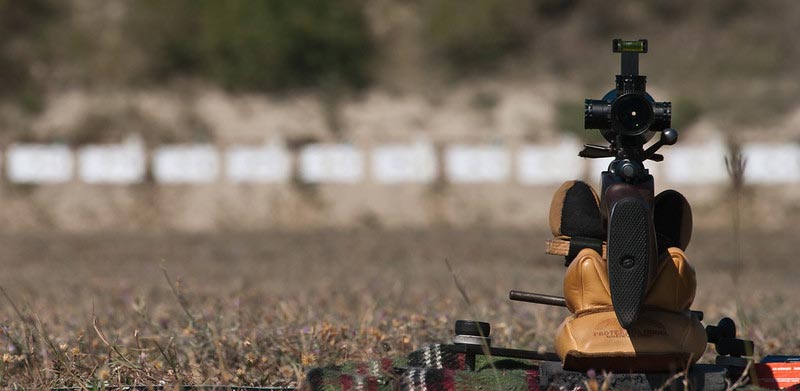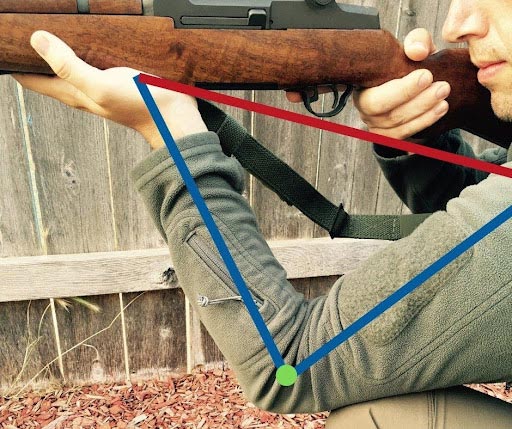This site contains affiliate links. As an Amazon Associate, I earn a commission from qualifying purchases at no extra cost to you. Full Disclosure Here.
So, you’ve equipped yourself with a rifle and an optic suitable for your needs, and now you want to brush up with a couple tips and tricks on how to tighten those groups up. I’ll share with you a few common tips and tricks commonly shared with PRS shooters. They are short, simple, and hopefully will improve your range experience.

First, and most importantly, is the golden rule of shooting. CONSISTENCY IS ACCURACY!! Consistently consistent consistency! The goal of consistency is to reduce the amount of variables, so that better corrections may be made. This applies to internal and external ballistics, as well as the shooters form and fundamentals.
Ensure that the rounds you’re shooting are repeatable (consistent). You need consistency in every aspect to have tight groups. Velocities, grain weight, type of powder, type of projectile, etc. All have to be repeatable. Match grade ammunition is manufactured with more strict quality control, meaning the manufacturer has attempted to get every round as close to the exact recipe as possible.
In order to ensure that your loads are as consistent as possible, load them yourself! After all, when you want it done right, do it yourself. Measure your own powder, seat each projectile at the exact same depth, measure twice and load once! Or, 1,000 rounds at a time if you like.
If you don’t have the equipment to do your own load development, purchase yourself a few different boxes of match grade ammo. Shoot them all in 5 round groups, and keep narrowing down your tightest groups to determine which factory load shoots the best through your gun. Every gun has microscopic imperfections, making every single gun slightly different (inconsistent) with the next. Find what shoots the best for you and get to practicing!
Before heading to the range, check over these 5 things that new shooters commonly overlook. Hopefully you will learn a couple tips and tricks that will lead you to tightening up your groups downrange, and nailing some targets farther than you have before!
1. Build on the Fundamentals of Marksmanship
Brilliance in the basics. Anyone who has ever excelled in their craft, first had to master the basics. You can’t excel, stand out, or get any training value out of “high speed” training courses if you haven’t mastered the basics. Even the pros spend numerous hours going back to the basics. Dry fire training, position changes, breathing exercises. These are all things you can go back to and improve upon. Let’s run through these 6 basic fundamentals.
Position: while in your shooting position, always ensure to have bone support, and muscular relaxation. When using muscle to support the weapon, your muscles will fatigue and become shaky. Your bones will not. Your skeletal system should effectively create a hardened shooting base.

Grip: There are a few different ways you can grip your rifle when precision shooting. The two most important things are, muscular relaxation and consistency. Do not squeeze the grip like you’re trying to shake your father in laws hand for the first time, and impress him with your grip strength. Instead, relax your hand with firm grip. Make sure you grip the weapon the same way every time. Shop around for a good pair of grips, that are comfortable for you. One thing you can try, is to avoid wrapping your thumb around the grip. Instead keep it outside the grip, and “pinch” the trigger inward instead of pulling it. I find this to be easily repeatable. It might not work for you, and that’s ok.
Breath control: Breath control is one of the most important fundamentals. This is something that should be practiced often. Your main goal of breathing control is to attempt to fire during your natural respiratory pause. The natural respiratory pause is the 1-2 second pause, where your lungs are empty after exhaling, and have not yet begun to inhale. Breathing muscles should now be relaxed, with the reticle at the shooters natural point of aim. Do not fire at the top of in inhale, when the lungs are full. You don’t breathe the same amount in every time. When your lungs are empty, they’re just as empty every time. Pause for an extra second before inhaling, and fire. This creates a very consistent shooting position, and is easily repeatable. For good training, increase your heart rate and breathing by doing some pushups or short sprints, and then run some dry fire drills, trying to calm yourself and fire at your natural respiratory pause.
Sight alignment: Sight alignment is so basic here that it’s hard to break it down any further. As far as scopes go, one thing I would say to do is make sure that your cheek is resting on the same spot every time. Have a consistent cheek weld. On my rifle, I sight in on a target, and get my proper cheek weld. Then I roll my mouth over until my top canine tooth makes contact with the stock. I then dig a tiny spot with a pocket knife. Now, every time I put my face behind the rifle, I put my tooth on the spot and roll my head until I can see through the scope. Now I know my face is in the exact position behind the scope every time! Consistency is accuracy!
Trigger squeeze: the most common mistake shooters make when squeezing the trigger, is anticipating the shot. Relax, slowly pull, and let the shot go off. The three most common types of bad trigger squeeze are flinching, bucking, and jerking the trigger. You can try the “pinching” method I explained in the grip paragraph above. Whichever method you chose, run A LOT of dry fire drills. Some people even balance a penny, or a spent casing on the muzzle during dry fire drills to ensure they are not flinching, bucking, or jerking the trigger. You can also have someone sneak a dummy round randomly in your magazine during live fire training. This is a very good way of realizing yourself how bad you’re anticipating the shot. Interupted and uninterupted
Follow through: Follow through important, and is easily the most overlooked fundamental of marksmanship. Proper follow-through means you continue the fundamentals until the round has exited the rifle barrel. Let that round fly for a second before racking your bolt back, changing positions, or making any movements. If you’re running a gas gun, let the rifle do what it does before moving. Very often people end up moving too fast, and find themselves firing and immediately moving their head, hand, body position, or anything that may move the rifle during the firing process.
2. Don’t Change Your Position
So we’ve discussed the fundamentals of marksmanship, and a few things you can do to practice them. You know they’re important, and you’re working on them. Great. There are a couple other things to keep in mind. You’re already aware of the golden rule; consistency is accuracy. Be consistent in everything you do. Therefore, don’t change your position! One thing I always see beginner shooters do, is unknowingly change their position. After every shot or two, the shooter will remove his face from the gun to grab another round, to rack the bolt back, to scratch his cheek, or for whatever reason… Then the shooter gets back on the gun and fires some more. This can easily contribute to having two separate groupings downrange. 5 with one cheek weld, and 5 with another. Or however the shooter broke it down. If you plan to shoot a 5 round group for accuracy, don’t shoot 2 in a low knee, shake your ankle out, and shoot 3 more. Be consistent, and just relax until firing is complete.
3. The Lower, the Better
Now you’re applying the fundamentals, you’re consistently in the same position every time, and you’re not changing your position until firing is complete. The next thing I like to have shooters work on, is getting into lower positions. Almost always, the lower the shooters position, the more stable the shooter is. Kneeling is more stable than standing, sitting more stable than kneeling, and prone is the most stable. In the sniper community, everyone knows the phrase “A shot is rarely taken in the prone”. This means that higher shooting positions obviously still need to be practiced. However, it is possible to lower each shooting position. (standing, kneeling, sitting.)
Standing: while in the standing, try bending over at the waist and getting lower. Lean into your tripod or shooting platform. Become a smaller target.
Kneeling: The kneeling position has several variants. The double knee, high knee (lol), medium knee, and low knee. The lower you go, the more bone support you will achieve, meaning you will have more muscular relaxation. However, each position decreasing in height requires more and more flexibility in the shooters lower body. If you try the low knee, and you are in pain, you will not have good muscular relaxation. You may be better off going to the medium knee, where you can achieve better muscular relaxation. It is very hard to have muscular relaxation while uncomfortable, because your body is trying to keep weight off of certain areas and using muscles in strange ways to compensate for the uncomfortable position. This leads me to my next tip.
4. Be Comfortable
When I first joined my Scout Sniper platoon, I was taught how to shoot the way my seniors shot. I was also the least flexible person in the Corps. I was so uncomfortable behind the weapon, that I could not achieve muscular relaxation, hell any relaxation at all. I would even wiggle every few moments to shake off the slight pain in certain areas of my body, changing my position. My advice on this, would be that every human body is different. Always give it your best shot at positioning yourself the way the pros explain it. However, being comfortable and being able to relax is very important. If you have to slightly adjust your position in order to be more comfortable, DO IT! Your body is not mine and does not feel the same as mine. Get in a low position, get comfortable, don’t change your position, and don’t move until you’re done firing. One thing you may do to improve your comfortability, is through stretching, and practice. Become more nimble, set yourself in these positions and try holding it for a few minutes each day. Eventually you will become comfortable in a position you weren’t capable of holding before!
5. Be Humble and Learn
This is by far the most important thing I can tell shooters looking to improve their shooting abilities. Too many people are too arrogant to attempt to change and get better. They think they’re doing everything perfectly, and often blame their gear for their shortcomings. You don’t know everything. And even if you do, you can always learn something new to better yourself. I like to learn something new every time I go to the range!
ASK QUESTIONS! Most people in the shooting community love talking about their new piece of gear, or what they’ve found works for them. This is a community, ask questions, and answer other people’s questions! Be honest with yourself and with others. If you enjoyed reading this, and have some common bits of advice you find you often share with shooters, post a comment below!

